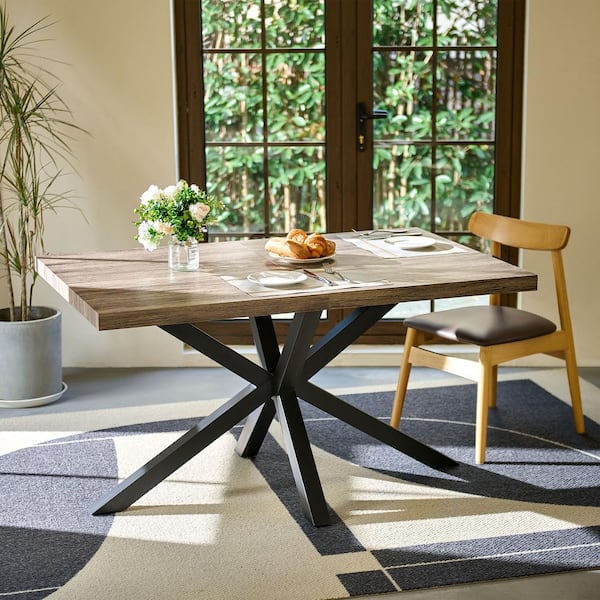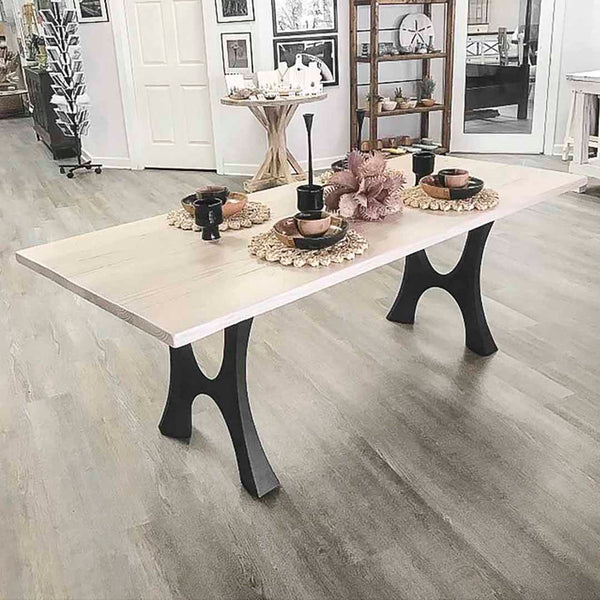Enhance Your Dining-room's Visual with Premium Dining Table Legs Wood
Enhance Your Dining-room's Visual with Premium Dining Table Legs Wood
Blog Article
What to Consider When Choosing Table Legs Timber for Your Home.
When picking wood for eating table legs, numerous crucial elements require cautious consideration to make sure both performance and visual appeal. The type of wood chosen can considerably influence the table's sturdiness, stability, and overall style, while the maintenance requirements may affect long-term functionality.

Value of Wood Type
When choosing table legs, the option of timber kind plays an important duty in determining both looks and toughness. Various wood types supply varying levels of stamina, resistance, and weight to wear, which can considerably affect the capability and long life of the table. Woods such as maple, cherry, and oak are usually preferred for their robust nature and ability to stand up to day-to-day usage. These woods not only offer structural stability however likewise withstand damages and scratches much better than softer options.
Conversely, softer timbers like ache or poplar, while more cost-efficient, might not provide the same degree of sturdiness and may call for even more frequent upkeep or substitute. The wood type also influences the table's capability to sustain ecological aspects such as humidity and temperature level changes. In addition, the choice of timber can impact the simplicity of completing and discoloring, which can be important for achieving the preferred look.
Aesthetic Factors To Consider
The visual allure of table legs significantly adds to the overall aesthetic of the eating space. Dining Table Legs Wood. When choosing timber for dining table legs, the grain color, coating, and pattern are critical components that can improve or take away from the area's design. Different timber kinds exhibit varying structures and tones; for instance, oak provides a traditional appearance with prominent grain, while walnut provides an abundant, dark style
Additionally, the form of the legs plays an important duty in specifying the table's personality. Streamlined, minimalist legs can create a contemporary feel, while a lot more luxuriant, turned legs evoke standard beauty. The design of the legs should harmonize with existing furniture and the overall style of the space, whether it be rustic, contemporary, or transitional.
It is likewise vital to think about just how the legs interact with other furniture items, consisting of sideboards and chairs. A natural layout not just elevates the dining experience but also contributes to the home's overall aesthetic coherence. Inevitably, the option of table legs need to be a thoughtful choice that reflects personal preference while making certain aesthetic consistency within the area.

Durability and Stability
Durability and stability are important factors in the choice of table legs, as they straight affect the long life and safety of the furniture. When selecting timber for dining table legs, one have to take into consideration the intrinsic properties of different wood types. Woods, such as cherry, oak, and maple, are often favored for their strength and resistance to wear, making them ideal for high-traffic eating locations.
In addition to the kind of wood, the construction method also plays a significant role Visit Website in the overall stability of the table. Legs that are solidly created, either with standard joinery strategies or modern engineering techniques, will offer superior support and avoid wobbling. It is vital to assess the density and design of the legs; thicker legs are typically much more steady and can stand up to higher weight.
Furthermore, the environmental problems in which the eating table will certainly be utilized can affect resilience. Wood that has actually been effectively dealt with for dampness resistance will certainly carry out better in moist atmospheres. Ultimately, picking the ideal combination of durable timber and secure building and construction will ensure that your table stays a secure and practical centerpiece in your house for years to find.
Upkeep Demands
Picking eating table legs made from durable timber is just the start; understanding upkeep requirements is just as crucial to preserve their look and functionality. Different timber types call for varying degrees of care, so it is important to understand what is required for your particular option.
Normal cleaning is basic; utilize a soft, moist cloth to eliminate dirt and debris. Prevent harsh chemicals that can harm pop over to these guys the coating. For wood surfaces like varnish or lacquer, routine polishing with furnishings wax can boost shine and supply a safety layer against scratches.
Preventative measures are vital also. Usage coasters and placemats to prevent straight call with damp or warm items, which can warp or stain the timber. Additionally, think about positioning felt pads under the legs to avoid scrapes on your floor covering and lower endure the wood
Humidity control is one more substantial factor; preserving a steady setting aids to prevent warping and breaking. Think about utilizing a humidifier or dehumidifier as required. if your dining area is susceptible to changes in temperature and wetness.
Budget Plan and Cost Elements
When intending to acquire table legs, recognizing spending plan and expense aspects is necessary to make link an educated choice. The kind of wood selected for the legs significantly influences the general cost. Hardwoods, such as oak or walnut, tend to be more pricey than softwoods like ache, because of their toughness, aesthetic appeal, and scarcity. In addition, take into consideration whether you are buying pre-made legs or opting for personalized styles, as modification usually sustains greater costs.
Labor and craftsmanship additionally play a critical duty in the overall expenditure. Handmade or artisan-crafted legs may bring a costs cost, mirroring the skill and time bought their creation. It's vital to evaluate the equilibrium in between quality and expense; spending much more ahead of time can lead to a longer-lasting product that calls for much less maintenance with time.
Conclusion
In summary, choosing the ideal wood for dining table legs demands mindful consideration of different variables, including wood type, aesthetic charm, budget plan, maintenance, and toughness restraints. The selection of woods such as oak and maple can boost both strength and aesthetic appeal, while softer woods may be more economical but less enduring. Ultimately, a well-informed decision relating to material choice will add to the overall functionality and longevity of the dining table, ensuring a beneficial investment for the home.
When picking timber for eating table legs, a number of vital aspects call for cautious consideration to ensure both functionality and visual allure.When choosing eating table legs, the selection of timber type plays an important function in identifying both aesthetic appeals and sturdiness. When selecting timber for eating table legs, the grain pattern, color, and finish are critical elements that can boost or take away from the space's design. When selecting wood for dining table legs, one have to take into consideration the fundamental residential properties of different timber kinds.In summary, picking the ideal timber for dining table legs requires mindful factor to consider of various aspects, consisting of wood type, visual appeal, sturdiness, maintenance, and budget restraints.
Report this page